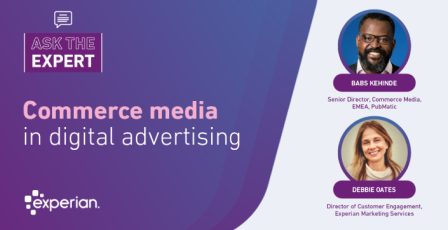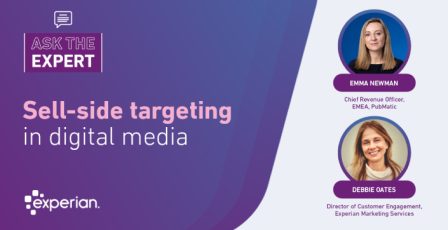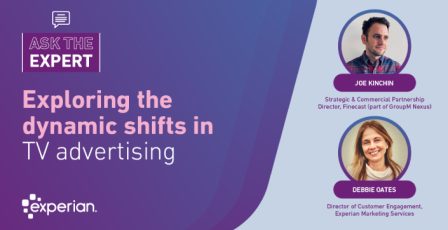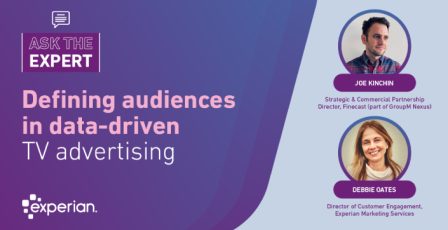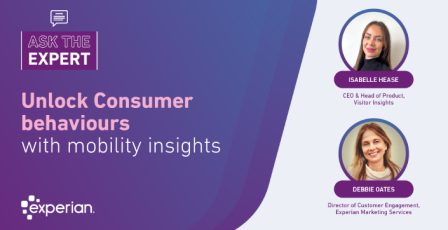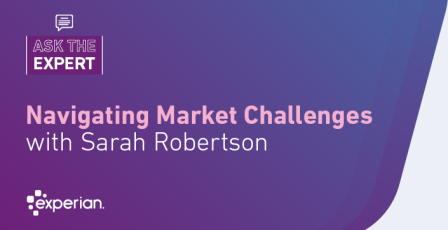Ask the Expert: Audience insights for advertising agencies with IPA
Ask the Expert: A Q&A series with AdTech and data intelligence experts
Embark on an insightful journey into the ever-evolving landscape of digital advertising with our ‘Ask the Expert’ Q&A series.
In this episode of our “Ask the Expert” series, Debbie Oates, Director of Customer Engagement at Experian Marketing Services, sits down with Simon Frazier, Head of Marketing & Data Innovation at the IPA. They discuss the critical role of audience insights in a cookieless future, exploring how agencies can continue to effectively understand and target their audiences.
- Introduction
The IPA represents the interests of advertising agencies across media, creative, and full-service domains. With around 300 agencies in membership, the IPA provides best practices in learning, professional development, insights, and legal services.
- Insights: The foundation of effective strategies
Debbie begins by asking Simon about the importance of insights in today’s data-driven world. Simon emphasises that insights are the foundation of effective strategies, enabling agencies to understand their audiences and target their campaigns with precision. However, he acknowledges the challenge of extracting actionable insights from the ever-growing amount of data.
- Collaboration: Key to generating valuable insights
To overcome this challenge, Simon highlights the importance of collaboration. By working together, teams can integrate qualitative and quantitative research, utilise diverse data sources, and ask better questions. This leads to a growth mindset within the industry, where practitioners are open to new approaches and making decisions that may not have been considered in the past.
- Sustainability: A growing focus in advertising
Another important trend discussed is sustainability. Simon emphasises that agencies are increasingly focusing on reducing waste and improving communication efficiency. This can be achieved through better targeting, understanding audience impact, and optimizing media strategies.
- Navigating the cookieless future: Innovation and human understanding
With the demise of third-party cookies, agencies are facing the challenge of understanding and targeting audiences in a new way. Simon emphasises that this shift is driving significant innovation and creativity within the industry. Agencies are finding new ways to reach and engage consumers, leading to new and innovative advertising solutions.
However, Simon also highlights the growing importance of human understanding in effective communication. Agencies are using data to understand people better, but they are also recognising the importance of human insights. This is leading to a more holistic approach to advertising, where both data and human understanding are used to create effective campaigns.
- The future of audience data and insights
In conclusion, Simon paints a bright picture for the future of audience data and insights for advertising agencies. By embracing insights, collaboration, and sustainability, agencies can ensure that their audience targeting and ad buying strategies are effective, efficient, and responsible.
Become an Experian agency partner
Our data and identity solutions help agency partners better understand and reach their audiences, enable accurate campaign attribution, and rely on accurate data with high match rates to reach new heights of client success.
Our comprehensive suite of marketing solutions helps agencies to:
- Onboard offline first-party data into the digital ecosystem
- Leverage our broad range of consumer insights, including demographics, spending habits, mobility, and research data, to better understand your audience
- Select or build scalable audiences through syndicated and custom data sets
- Reach audiences across programmatic, CTV, social, linear TV, email, and direct mail
Connect with our expert team
Let Experian be your partner in helping your clients succeed.
Start connectingHi, and welcome to the next episode of Ask the Expert, where I’m joined today by Simon Frazier from the IPA, and we’re going to be discussing the importance of audience insight and how it’s developing in the midst of a cookieless future.
Thank you very much for having me today.
Just to start us off, Simon, can you tell us a little bit about the IPA and what you do and who your members are.
So the IPA represents the interests of advertising agencies, and that’s across media, creative, and also full service as well.
And we have currently around about agencies in membership, and what we provide for that is essentially best practice within the industry in terms of learning, professional development.
We provide insight and legal services.
So there’s a number of different angles.
Can you tell us a little bit about your role there.
So I work primarily within the Touch Points team and the Media Research Department at the IPA.
Touch Points is the industry standards for cross media measurement in terms of enabling all media to be planned on a side-by-side basis using the underpinning joint industry measurement currencies and data sets like BARB and RAJAR, for example.
And within that, I work on a number of initiatives to improve the usage of the data to essentially make planning for agencies a more streamlined process.
What does insights mean to you in terms of this conversation.
I’m really curious.
In an age where there is so much data, we know more now than we ever did, but equally, the more you have, the more it makes it hard to really get to the root of what actually an insight is.
But invariably, I think what true insight is, it may be just a small amount of information that you eventually drill down to that enables you to really identify something unique and actionable about an audience that you’re actually able to do something with.
In terms of your agency membership base, how important is that type of insight to enable them to plan effectively and to understand their audiences.
I think paramount importance.
I would think of insight as being like the foundations of the strategy which then evolves into that.
I think without strong basis within insight, the strategy that you build upon there, it’s like building a house with no foundations, it’s going to start falling down.
I think truly getting to the heart of understanding audiences, their motivations, the way in which media interactions might fit within their life, how they spend their money, gives that fundamental capability for them planning a strategy for how can we talk to people.
So how can agencies work with data to really hone in on who that target market is.
Well, I think within agencies there’s a fantastic skill set within the insight teams, within the strategy teams and also all of the client teams there.
And increasingly since COVID what we’ve seen is much better collaboration, I guess, working towards the idea of a shared goal.
How important is it that the tools that the agencies are using then are really simple to cut through and enable them to get that insight.
So I think simplicity and the capability to get to those golden insights and to really understand the audience is so, so important.
We can have as much data as you want, but the quantity of insight, I think getting to that has got harder.
The more data we have, the more difficult it’s become.
Equally, though, as we’re moving towards a world where certain data sets, third party cookies for example, are no longer going to be available, I think it’s the limitation of that is what’s really driven the innovation and the creativity across the industry, across agencies, across data providers, across media owners and across clients, to go, “Right, let’s have a real good look at what quality data we have here that we can rely on.
“And the other thing we’re seeing is just really great dashboards, tools that are universally understandable and capable of delivering those audience insights.
How are you seeing agencies lean into some of the newer sources of data that are coming onto market.
So that being things like mobility insights link to demographics, transactional spend information linked to demographics and the likes.
I mean, all of these data sets, I think, are really helping to build out that fuller picture of the customer journey.
Particularly with mobility data, it helps you see the points of contention within that purchase journey or potential limitations.
And I think that’s really important in shaping the customer experience.
Any views in terms of how people are utilising spend data.
Absolutely.
We’ve had so much data, particularly in the FMCG category, within the supermarket data sets, the loyalty schemes that are occurring there.
But actually, I think what’s so important is those data sets that enable us to understand the full scale of spending and the context of that spending in which it’s occurring, and that’s across all transactions.
Then we can understand more about how to effectively communicate to the individuals in question.
It enables you to see not just the isolated individual category, but you can see, right, maybe there’s a pinch on spending in this area because there’s other purchases that are occurring adjacent to that in other categories that we might not have understood about with a single source individual shopper data.
Simon, talk to me about cookies and how signal loss is going to impact the generation of these types of audience insights.
One of the things that I think particularly it has done is, invariably we have so many tools at our disposal, and often you might have traditionally just used them for one specific thing, but now, it’s a kind of, what’s really exciting for me is you’re seeing people go, “Do you know what, I didn’t know it could do this and this.
“And you’re finding out a lot more because when you suddenly go, “Well, third party cookies aren’t going to be something we can use anymore, well, what have we got here that can enable us to do that.
“Wow, why haven’t we been using this all along.
Why haven’t we used it before hand.
Yeah, exactly.
That’s really interesting in terms of taking that positive spin.
There’s an awful lot of noise in the industry at the moment around it, but that positive spin in terms of how people are adapting anyway, is great.
At the recent IPA event, we heard an awful lot around the importance of understanding the human element as well.
How do agencies approach that.
Ultimately, what we’re trying to do is we’re trying to communicate effectively to people.
And one of the skills that particularly we see within agencies is that ability to really get to the heart of the people that they’re communicating with.
One of the really interesting things that Vicky Fox, who’s the Chief Planning Officer at Omnicom Media Group said is the most important thing you can do is walk a day in your customer’s shoes.
So that, I think, is where bringing in that really strong understanding of the human element in the data that we’re using, you know, getting to the heart of why people want to engage with the brand or why people might be pulling back from the brand is really important.
And I think the data that we have in the industry is fundamental to enabling us to do that, to get to the heart of the people.
Do you see that mix of quantitative research and qualitative research playing very much into that particular area.
Absolutely.
We’re seeing a more integrated approach where the two sides are working more collaboratively together, and I think that helps on both sides.
It helps the quantitative side to really get a bit more of the direct personal human understanding.
But equally from the qualitative side, it helps to really get the quantitative data behind it to inform the decisions and the way in which the questions are framed and asked.
Simon, we’ve spoken an awful lot around insight and developing understanding the consumer.
I suppose the interesting piece then is potentially the disconnects between all of the planning that goes on and then how that gets pushed through into execution of the campaigns.
What are the challenges that agencies face here and how are they overcoming them.
I think one of the challenges that you have, and it’s an increasing thing that we do here, is, well, I can plan this audience and I can put all of this data in, but when it comes to certain media, I’m only able to buy this particular target audience or I’m able to buy or trade in that way.
But one of the things, I guess if we move away from, if we zoom out a little bit, I think if we have that fundamental understanding that’s created in the planning phase, utilising as much of the best quality data as possible to really frame and understand that audience, in some instances or online media, we may be able to activate directly against that target in other media.
I think really the capability, or the best usage is to start looking at what we can trade with and let’s look at how the indices against the particular target that we’re looking at.
And then, and this is where I think, you know, if…In an oversimplified way it would be seen as, well, we can plan this and we can trade that, but actually, what the great planners are then doing is they’re then going deeper into those trading data sets to find out when’s the optimum time where I’m going to reach the planning target that we’re looking at the particular point during the day or in a particular media, for example, not just looking at it across the whole day or across that whole period, and then drilling down and looking at the indices and then planning and buying that in the most effective, not just the most efficient way possible.
Where are you seeing the trends within the IPA at the moment.
Well, I think one of the key trends we’re seeing is a real focus on far fuller integration of effectiveness cultures within agencies right through from insight and strategy phases right through to activation and implementation phases within agencies.
So effectiveness is no longer a case of, well, let’s look at it in terms of post campaign analysis.
It’s that constant mindset that exists throughout the planning and implementation process.
The other thing I think that’s really important is that agencies are increasingly using data in very innovative ways.
They’re building new dashboards, they’re incorporating more data sets than I’ve ever seen before.
They’re doing things with data that I never even would have thought possible a few years ago.
I think it’s a really exciting time to witness all of those changes occurring.
We’ve covered an awful lot within the conversation today, just as a close, are there three emerging trends that you can call out for us that are going to impact agency buying as we move forward.
The first trend that I think is going to be more important than ever is collaboration.
I think working collectively and actually asking better questions as a result of that, constantly having that kind of approach is really going to shape the way that we work going forward.
And I think that leads onto the…I guess the second trend that I would say would be a really good embodiment of that growth mindset within the industry.
We’re seeing approaches that are really focused on increasing capabilities and actually sometimes moving away from those misconceptions or preconceptions and allowing data and allowing the extensive capabilities of the practitioners with the industry to make new decisions that perhaps in the past they might not have done in how they approach media.
As media is evolving and we’re getting many new media platforms that I guess have less of an established history in traditional advertising approaches.
And the third point that I would mention would be sustainability, because I think that’s increasingly important.
It always has been incredibly important, but I think now we’re really focusing on sustainability in the long-term future of the advertising industry.
And I think in terms of what we’ve been talking about today, if we’re able to use data to better understand people, if we always have that effectiveness mindset, if we always have that growth approach to the way in which media is being traded and being planned, the strategy and the insight, we’re actually able to make decisions which are going to communicate more efficiently in terms of sustainability and also with an understanding of the impact that that communication is going to have on the environment in terms of sustainability.
And ultimately less wastage and better targeted data, better understood audiences, better communications, all result in a reduction in the amount of wastage that is occurring.
And ultimately all of those things together combine to drive better results for the clients.
Thanks, Simon.
That’s such an important point to finish on.
Fantastic.
Well, thank you very much indeed for having me.

